Endangered animals in the Congo rainforest
Endangered animals in the Congo rainforest
The Congo rainforest is the second-largest tropical rainforest on Earth and is nicknamed the ‘lungs of Africa’ for the oxygen it provides. In its 220 million hectares live millions of different animal and plant species, including 11,000 tropical plant species—30% of which are unique to the Congo—over 1,200 bird species, 700 fish species, 450 mammal species, and about 280 reptile species. The Congo Basin provides 70% of Africa’s total plant cover, making it a vital carbon sink.
The Congo rainforest is also home to some of the world’s most endangered species, like the African forest elephant, the grey parrot, and both species of gorilla. Some of the most common threats faced by these animals include poaching, habitat loss, and the exotic pet trade.
Here is a list of endangered animals that are found in the Congo Basin, from the largest frog in the world to one of the biggest land mammals.
Okapis
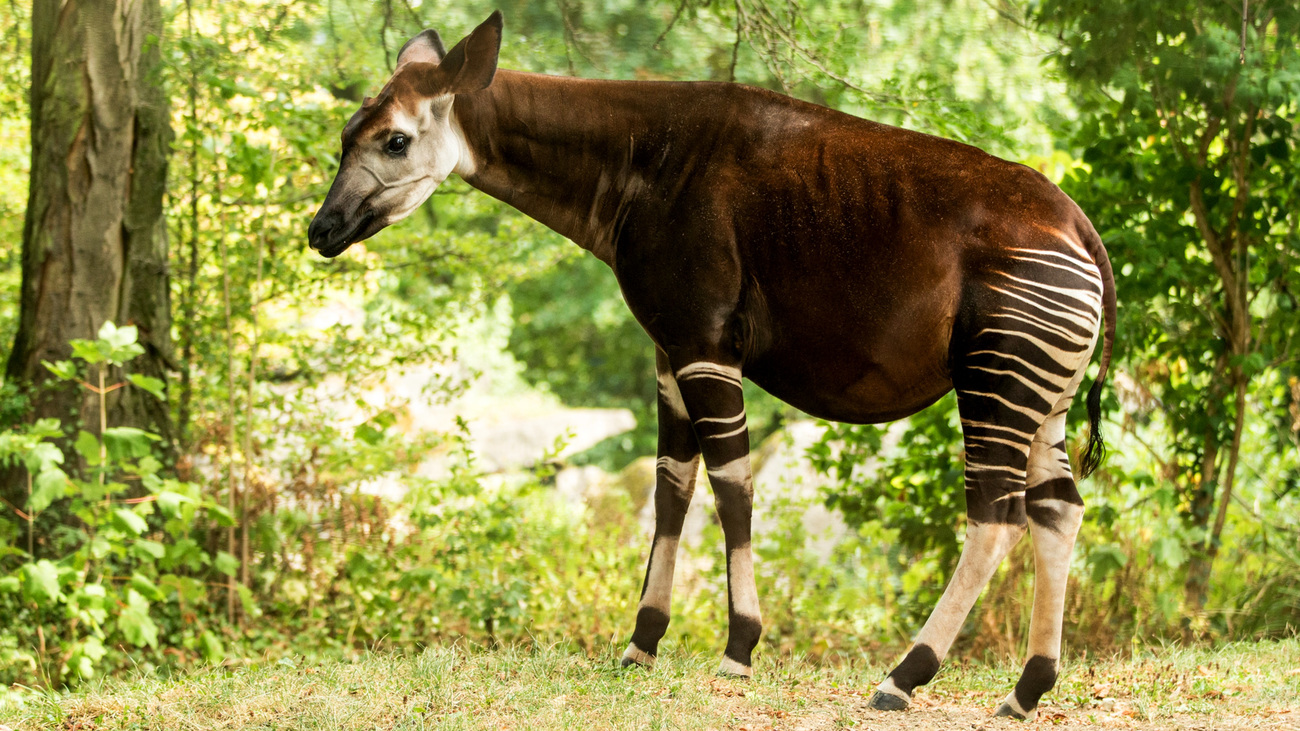
Also called forest giraffes, okapis (Okapia johnstoni) are hoofed mammals famous for the zebra-like stripes on their legs. Okapis are the only living family members of giraffes, and they’re found only in the Congo Basin. While they can coexist with small human settlements and low levels of disturbance, they are increasingly losing their habitat due to more major human activity, including logging and the illegal occupation of protected areas. Okapis are also frequent targets of hunting—hunters use snares to catch them and acquire their meat and skins.
Another major threat to okapis is human conflict. There is a presence of armed groups around their range, including in crucial protected areas. Their presence prevents conservation actions and monitoring of the species, and they also perpetrate illegal activities like bushmeat hunting, mining, and logging. For these reasons, okapis are endangered.
African forest elephants
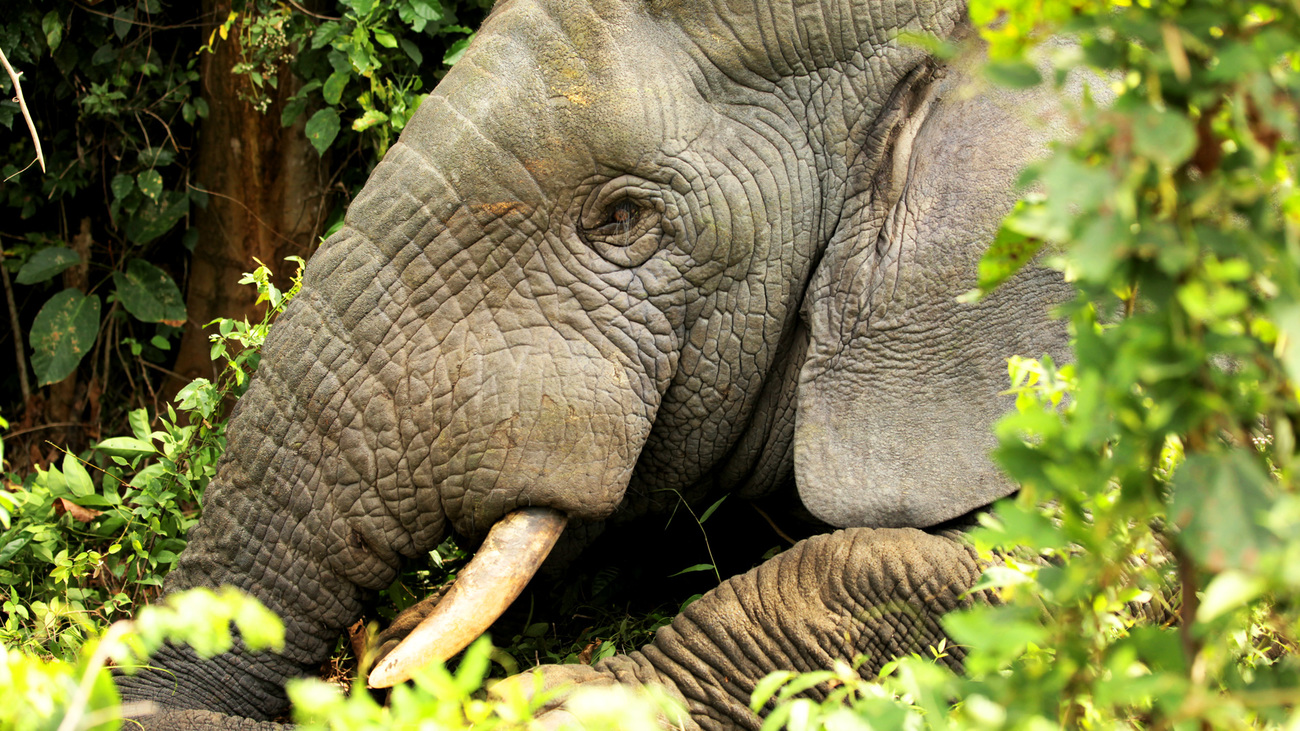
Slightly smaller than their African savannah elephant cousins, African forest elephants (Loxodonta cyclotis) are the second-largest land mammals in the world, and a large part of their population occupies the Congo Basin. They are critically endangered, and poaching remains the biggest threat to their survival. Elephants are poached for their ivory tusks and their meat, and while trading ivory is illegal around the world, it still happens on the black market.
Habitat fragmentation is also severely impacting these elephants. As more and more land is converted for agriculture, settlements, and infrastructure, elephant populations have less space and become separated from one another. This leads to a rise in human-elephant conflict and a decline in elephant numbers.
Gorillas
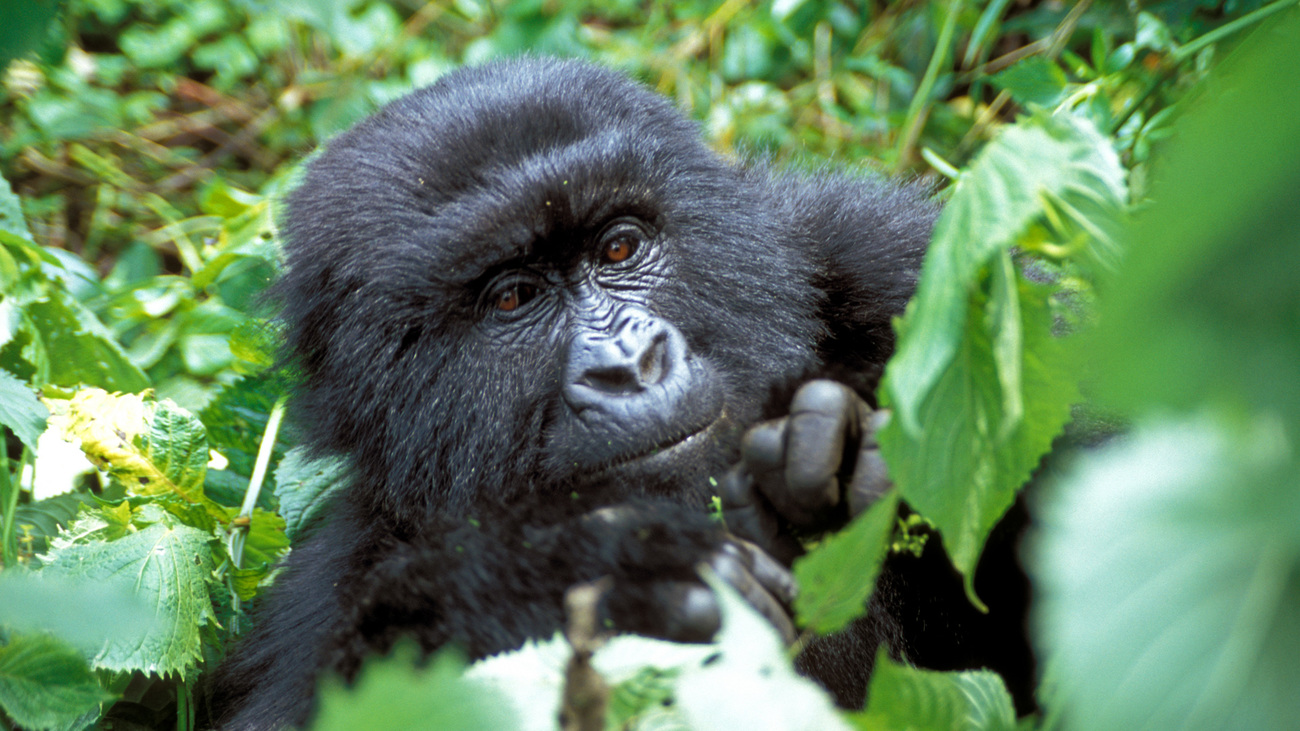
The two gorilla species—the eastern gorilla (Gorilla beringei) and western gorilla (Gorilla gorilla)—are both found in the Congo Basin, and they are both critically endangered. There are 2,600 eastern gorillas estimated to remain in the wild. The eastern lowland gorilla, also known as Grauer’s gorilla, is the largest gorilla subspecies.
One major threat to gorillas’ survival is poaching for bushmeat due to a scarcity of protein sources. Infant gorillas are also often captured after their mothers have been hunted and killed, and they typically die in captivity or are seized by wildlife authorities. Armed conflict in the area has brought about a rise in the circulation of illegal weapons, which has made poaching much more rampant.
Deforestation is also a major threat to gorillas, and it is perpetuated by the civil unrest faced by the region. The presence of armed groups and refugees in parts of the Congo Basin is putting enormous pressure on the forest and its animals as land is converted for settlement, agriculture, logging, and mining. Diseases spread from humans to gorillas also pose a threat.
Western gorillas in particular are facing threats from oil palm plantations, as much of their habitat is suitable for this type of agriculture. It’s estimated that 73.8% of the habitat of the Western lowland gorilla subspecies could be converted for oil palm plantations.
Lastly, the increased temperatures and altered rainfall patterns caused by climate change are expected to have a major impact on gorillas’ habitat. Climate change is already impacting the food security of humans, who will continue to encroach on gorilla habitat if they cannot secure sufficient resources.
Chimpanzees
Chimpanzees (Pan troglodytes) are another endangered great ape species found in the Congo Basin. They are regarded as our closest relatives out of all primates, sharing 98.7% of our DNA. Despite how the killing and consumption of all great apes is banned, poaching remains one of the biggest threats to chimps. They are hunted with guns and trapped with snares, including snares set with the intention of catching other mammals. Infant chimps whose parents are killed are often taken as pets or enter the illegal wildlife trade.
Chimps are also sometimes killed in retaliation for crop raiding, a form of human-wildlife conflict. Conflict between humans and chimps is becoming more intense and is perpetuating negative attitudes about these apes. Additionally, chimpanzees are losing their habitat to agriculture, logging, mining, and other human activities.
Because of our similarities in DNA, many infectious diseases can be passed back and forth between humans and chimpanzees. One of these is the Ebola virus, which has caused a series of mass chimp die-offs.
Bonobos

Bonobos (Pan paniscus) are also members of the great ape family and are found exclusively in the Congo Basin. The species is endangered and threatened by poaching and habitat loss, and due to a lack of education on bonobos among both urban and rural communities, it is not widely known that hunting and eating bonobos is illegal. Because bonobos reproduce slowly, it is difficult for their population to recover from shocks.
In many local communities, there is a taboo against hunting and eating bonobos. However, many of the poachers who target bonobos have travelled in from other places, and many commercial poachers are also active, even in protected areas.
As it has for other apes, civil unrest in the area has increased poaching and habitat loss for bonobos. This is due to the proliferation of illegal weapons and the displacement of many people from their homes.
In addition, oil palm plantations threaten bonobo habitat. It’s estimated that 99.2% of bonobo habitat is suitable for oil palms, which means that if this industry persists unregulated, bonobos’ habitat could be completely decimated.
Poaching leaves many young bonobos without their parents, and they can become easy victims of wildlife trafficking. IFAW supports the rehabilitation of rescued bonobos at Lola ya Bonobo, a sanctuary and release site operated by Friends of Bonobos.
Pangolins
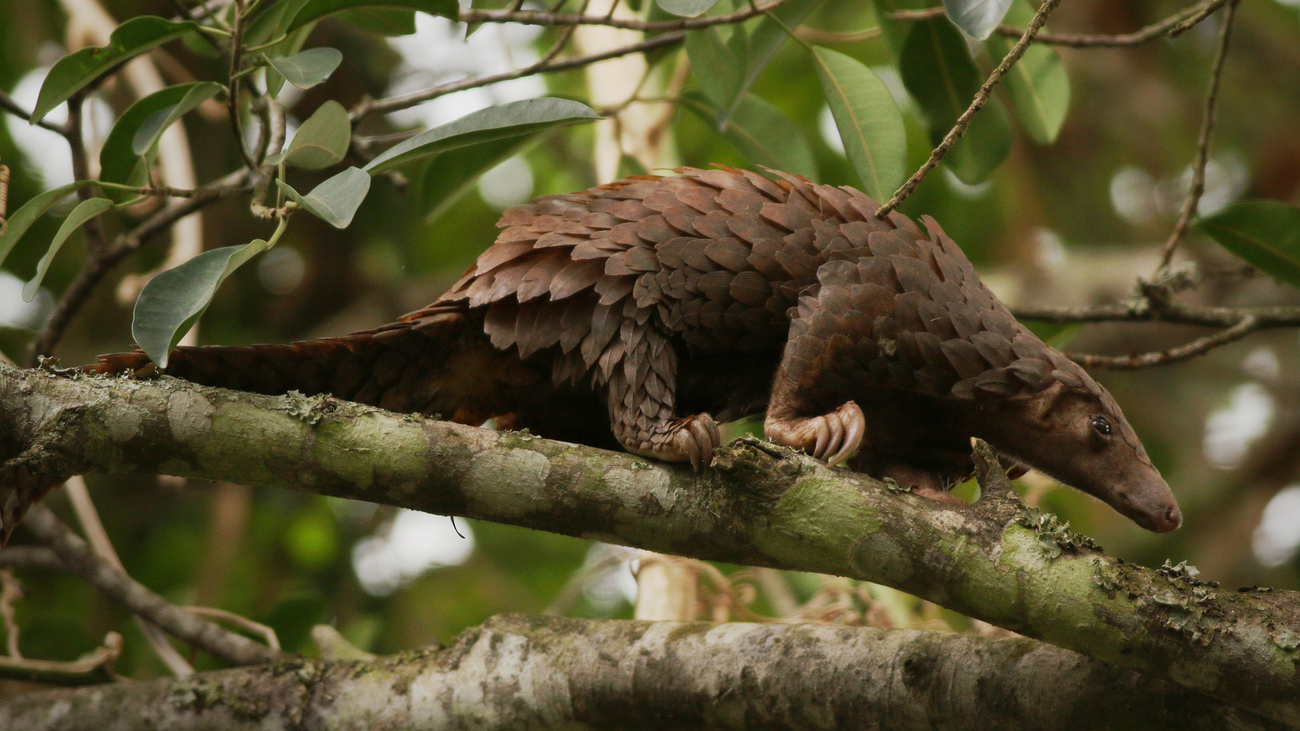
Two endangered species of pangolins are found in the Congo Basin—the white-bellied pangolin (Phataginus tricuspis) and the giant ground pangolin (Smutsia gigantea). These shy, scaly mammals have been decimated by poaching for their meat and scales, which are often illegally traded for traditional medicine.
Since the beginning of June 2023, three white-bellied pangolins (Manis tricuspis) and one black-bellied pangolin (Manis tetradactyla) have been seized in Dimonika. Using the CARE protocols and materials, all four were held and transported to JGI’s Rehabilitation Center. All four were successfully reintroduced following veterinary examinations. White-bellied pangolins are the pangolin species found most often in bushmeat markets. One 2019 study found that scales from about 200,000 African pangolins were seized in trade in just a three-year period (2015 to 2018).
Habitat loss is also a major threat to pangolins, primarily in the form of deforestation. Their habitats are also disturbed through agriculture, mining, quarrying, and oil drilling.
African grey parrots

Widely regarded as some of the most intelligent birds in the world, African grey parrots (Psittacus erithacus) are native to the Congo Basin region. These birds are endangered, and their population has been estimated to decline by 50% to 79% over three generations (43 years). This is due to both live capture and habitat loss.
Despite their large size and lifespan that can extend as long as a human’s, African grey parrots are one of the most sought-after birds for the exotic pet trade thanks to their intelligence. Over 1.3 million of these birds entered international trade from just 1982 to 2001, and the capture of these birds from the wild persists to this day. It’s also estimated that 30% to 66% of grey parrots die from this practice before they even enter the trade, so the total number of parrots impacted is even higher.
Not only are they targeted for live trade, but African grey parrots are also hunted for bushmeat and their parts, including their feathers. In addition, they are losing much of their forest habitat. Large trees with cavities for nesting are crucial for this species.
In 2016, IFAW joined forces with African governments and other organisations to get African grey parrots upgraded protections under CITES. IFAW also supported the Uganda Wildlife Authority, Conserv Congo, and the World Parrot Trust alongside the Wildlife Trust of India to investigate a trafficking case, which led to the seizure of 122 African grey parrots from a trafficker from the Democratic Republic of the Congo (DRC). The birds were transported to the care of the Uganda Wildlife Conservation Centre, successfully released, and continue to be monitored in the wild.
In 2023, a sting operation led to the arrest of four men and seizure of 45 grey parrots in the Republic of the Congo. Authorities immediately contacted the Jane Goodall Institute, implementing partners of IFAW’s Confiscated Animals – Rescue and Enforcement (CARE) project, for support in the handling and transport of the parrots to long-term captive care. The CARE project is made possible thanks to the generous support of the US Department of State, Bureau of International Narcotics and Law Enforcement Affairs (INL).
Meanwhile, in the DRC, IFAW partnered with World Parrot Trust and the Lukuru Foundation in the logistical facilitation for 16 confiscations and voluntary submissions (totaling 453 parrots of African grey parrots) by DRC state agents between August and December 2023. Many of these confiscated parrots were deemed candidates for rehabilitation and what will hopefully be a tremendous milestone of release back to the wild.
These confiscations also allowed us to identify project collaborators in two sectors of Maniema province where the parrot trade remains rampant and vulnerable parrot concentrations occur. IFAW support continues to enable monitoring of shipments through major transit points for the parrot trade.
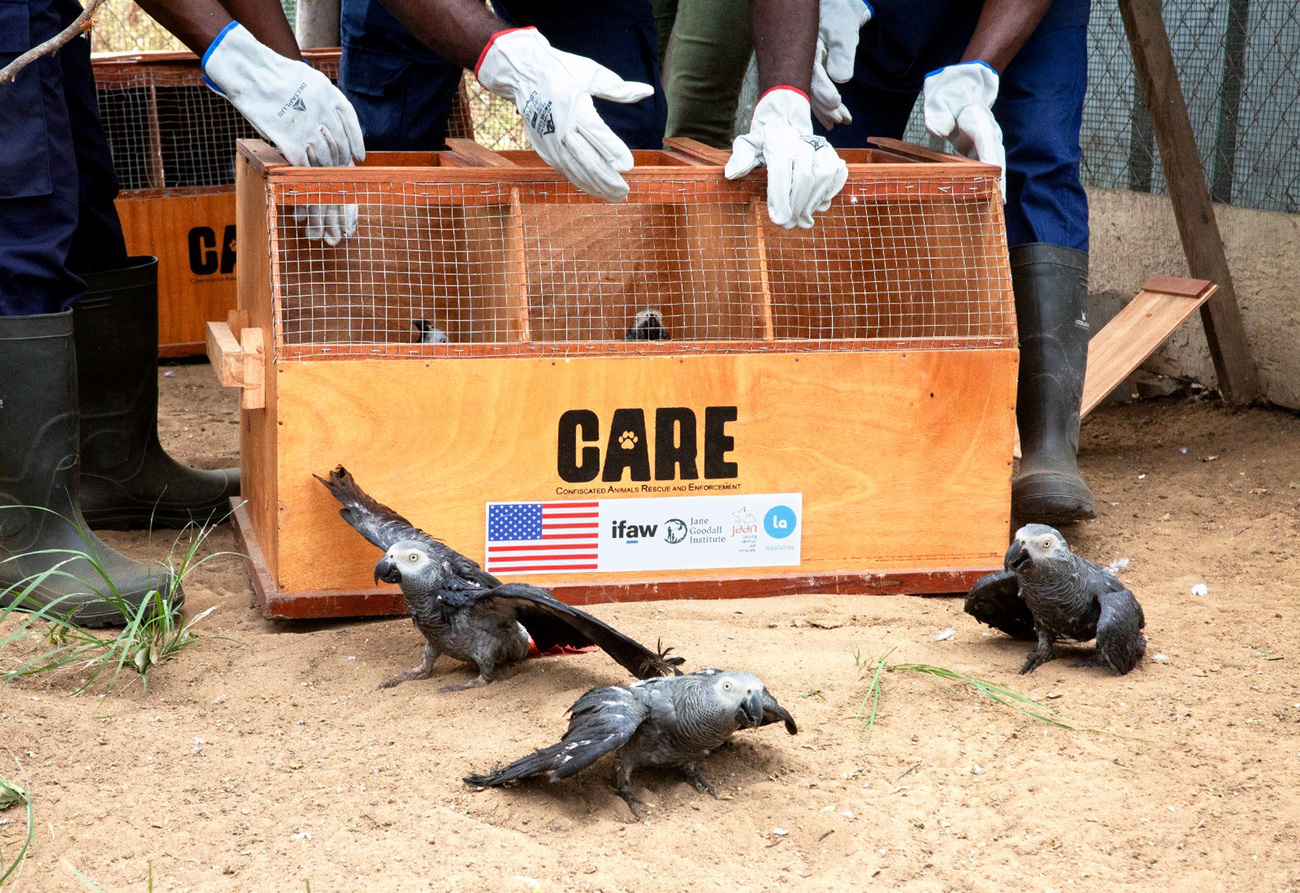
Meanwhile, in the DRC, IFAW partnered with World Parrot Trust and the Lukuru Foundation in the logistical facilitation for 16 confiscations and voluntary submissions (totaling 453 parrots of African grey parrots) by DRC state agents between August and December 2023. Many of these confiscated parrots were deemed candidates for rehabilitation and what will hopefully be a tremendous milestone of release back to the wild.
These confiscations also allowed us to identify project collaborators in two sectors of Maniema province where the parrot trade remains rampant and vulnerable parrot concentrations occur. IFAW support continues to enable monitoring of shipments through major transit points for the parrot trade.
Goliath frogs
Also known as the giant slippery frog, the goliath frog (Conraua goliath) is the largest living frog in the world. These frogs are only found in Cameroon and Equatorial Guinea, inhabiting fast-flowing rivers and streams in the Congo rainforest. They are endangered.
The primary threat to goliath frogs is hunting for human consumption. These frogs are hunted by locals and for trade in bushmeat markets. Goliath frogs are also targeted for the international exotic pet trade—they are imported to the US from Cameroon on a regular basis for the pet trade and zoos. In the past, they also were imported to the US for frog racing, a cruel and unnecessary practice.
Goliath frogs are also losing their habitat to agriculture, including cocoa, banana, and palm plantations. Logging, human settlements, and new roads also degrade the forests where they live. The streams and rivers on which the species relies are facing sedimentation and chemical pollution.
Slender-snouted crocodiles
Slender-snouted crocodiles (Mecistops cataphractus) are critically endangered reptiles found in the Congo Basin. There are as few as 1,000 of these crocodiles remaining, and their population is decreasing. They have experienced decline due to the commercial hunt for their skins, subsistence hunting, and habitat destruction. Though the hunt for their skins has declined due to their decreased population, fisheries, habitat loss due to agriculture, and bushmeat hunting are preventing the species’ recovery.
Want to help these animals and other endangered species around the world?
Related content
Every problem has a solution, every solution needs support.
The problems we face are urgent, complicated and resistant to change. Real solutions demand creativity, hard work and involvement from people like you.